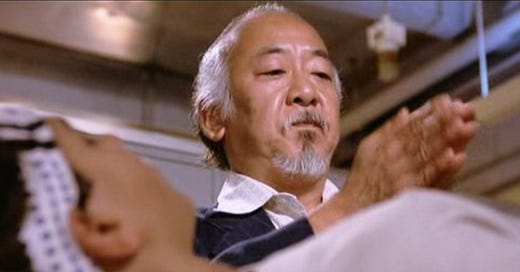What Did Daniel LaRusso Teach Us about Getting a Massage?
Also, Make Massages a Part of Your Peak Season
If you’ve seen the classic film The Karate Kid, then you no doubt recall the scenes featuring Mr. Miyagi’s “magic hands” technique where he heals Daniel’s ailments. You likely also recall that Daniel screams, “OWWWW!” the first time it happens. Bottom line: Don't hesitate to tell your masseuse that he/she is pressing/thumbing/pushing too hard! We like to assume that an “expert is, as expert does,” and I generally agree. However, sometimes, it's simply too much.
To take a step back for a moment, make sure that you purposely use massages as a chance to also practice exhalinggggg (long and slow). For those that practice any type of meditation/mindfulness, you’ll certainly agree that 9x out of 10, these long, deliberate exhales will take the tension/pressure out of your body during that hard pressure, of which your masseuse be might also be repeating the phrase “relax”. As a quick side note, “relax” is often an overused/abused instruction in the world of athletics because many coaches/clinicians don't actually convey what-the-hell it actually means. So, contextually, in terms of a pro massage, the word “relax” means exhale in order to relax your muscles, including face/jaw, to allow them to press deeper into the “trouble spots” (a.k.a., “relax” doesn’t mean “brace for impact!”).
However, to bring this main point full-circle, yes, there is that 1x out of 10 when you need to tell them “too much” or “more softly, please”. Your own individual personality type might make this action more of an obstacle than it could/should be, but trust me, they've heard it a hundred times before, so don’t hesitate to be vocal…it's YOUR massage! In other words, if you are tensing-up too much because the massage pressure is too hard, then you’ve just defeated the purpose of that session.
To reiterate, massages can be used as a lesson in how to become more in tune with your heart rate and breathing, as in learning what it takes to achieve a state of relaxation in a very quick time frame, such as 1 - 10 seconds. Use massage sessions to practice positive self-talk to relax the body. The masseuse is just there to assist that practice, like a shaman of sorts. There is certainly a strong reciprocal relationship between mind and body, and any lessons learned in this regard (i.e., while lying on the massage table) can be applied to race day. Additionally, be sure to pay attention to any differences in tension/tenderness between each side of the body. Yes, it's nice to space out during a good massage, but maintain awareness(!), as this will provide useful feedback to carry into your ST workouts.
Remember: A good massage that does its job will leave your muscles slightly fatigued for 24-72 hours, so that's why I do NOT recommend a massage “a few days” before the peak event (A-race). Therefore, get it done the week prior, which is often also another light week anyway.
“How often should I get a massage?” I schedule my athlete for a Recovery Week every ~5-9 weeks (individual variables pending), and I recommend a pro massage in this same loose time frame (pending one’s budget and other variables). Self-massage is certainly a great tool, but treat yourself to the “real deal” during your recovery weeks. Don’t hesitate to try a new masseuse each time or to try a new massage therapy practice. We are usually very (very!) loyal to our hair stylist and barbers (as we should be, there is only one match for us in this regard), but don’t be too shy to try a different massage therapist…it’s is like getting a 2nd PT opinion regarding how your body is aligned. On that note, it doesn’t necessarily have to be a “sports massage” either. Keep an open mind.
Massage, or self-massage, is a great way to help maintain range of motion. Massage, as a form of muscle manipulation, is typically superior to static stretching in terms of correcting the body. Stated alternatively, in terms of increasing the flexibility of a joint, if given the choice between static stretching and self-massage, I would encourage the latter. Both can be beneficial, but self-massage or any form of muscle manipulation (e.g., Graston technique or Active Release Technique/ A.R.T.) is more beneficial because it addresses the root of the problem. Because the connective tissue encasing each muscle (the fascia) is strong and requires constant stress to change its shape, only direct pressure can change the shape of the fascia. Static stretching does not provide this type of pressure. As our muscles become tight by sitting frequently and/or months or years of being sedentary, the muscles conform to these positions. If muscles are going to move into new ranges of motion and we intend to lessen the tightness that the muscles have developed, then direct manipulation of the muscles is needed. Again, this is accomplished through some form of massage, not static stretching, though the latter has its merits.
Again, self-massage techniques, like foam rolling and The Stick, are wonderful modalities of self-care, and so is rolling your arches over a lacrosse ball or rolling your upper back over a trigger-point ball, but every now you need to have someone dig into those harder to reach spots! Similarly, getting a relaxing shoulder rub at home is one thing, but a pro massage is a better way to reshape the connective tissue. With that in mind, massage starts to make more sense when you realize how much more training you do than what your general health actually requires, right? There are countless other recovery methods, including acupuncture, PT, A.R.T., Muscle Activation Technique, Graston technique, crypotherapy, clean diet, and sleep, etc., but one item on your Sept - Nov to-do list should be a massage ~7-10 days before your peak race(s)…and don’t be afraid to pull a LaRusso and say, “OWWWW!”
Train Smarter, Not Harder!
Mike




